|
2003年在雲南省麗江看玉龍雪山的時候,有對年青人告訴我們,他們的夢想,就是去看神秘的梅裏雪山的金光照頂;能看到它的人都是幸運的,很多人在那兒守了很多天都看不到。梅裏雪山位於青藏高原,海拔六千七百多米,屬於藏區。十二月,我們由虎跳峽經白水塔到香格里拉後,趁著當時雪未封山前,繼續前往德欽,去拜訪神秘的雪山。汽車在經過蜿蜒顛簸的山路十幾個小時後,才到德欽,我又冷、又累,頭又痛。當地是海拔三千九百米左右,我們就在觀看梅裏雪山的客棧住下,沒有人知道第二天梅裏雪山是否會露面。第二天我們做了早課,便拿著照相機到雪山前去等候;隔壁屋頂上已有一批專業照相人士架好攝影機、照像機在等著,大家都只是靜靜的耐心期待。一會兒天微亮了,突然像蠟燭一樣,出現了一個金色的尖頂,啊!雪山出現了,金光照頂!童話故事書中美麗的梅裏雪山現形了,大家都非常的興奮!每個人帶著滿足,互道恭喜。
這時正是癸未年(六十年來一次的閏羊年),藏族人都誦著六字大明咒在轉山,大轉21天,小轉7天;而羊又是西藏人最崇敬的動物,所以是個盛大的活動。我們很想加入他們,但一方面對海拔高度已有些高原反應的症狀,另方面也怕萬一下雪,山路會封而回不去了;因此喝了酥油茶及渣粑後依依不捨的離開。走到半路,太陽在東方才漸漸的升起。
2006年十月,我們費時三天兩夜,由怒江翻過碧羅雪山,一日步行十幾個小時,夜宿無頂牧場;再沿瀾滄江,趁車前往德欽,而入梅裏雪山。
|
|
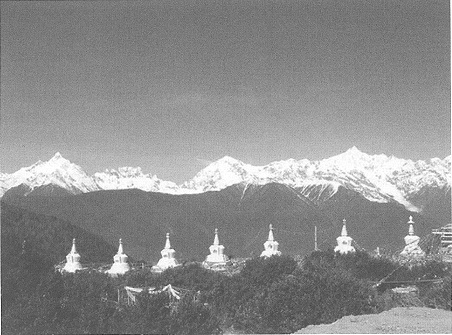
In 2003 at Yulong Snow Mountain in Lijiang of Yunnan Province, a pair of teenagers told us that it was their dream to go see the mysterious “golden gleaming of the summit” of the Meili Snow Mountain. Those who were able to see it were fortunate; many people waited for days without getting to witness it. Meili Snow Mountain is located in the “highland of Qinhai-Tibet” at 6,700 meters above sea level. In December we arrived at Shangrila from Tiger Leaping Gorge via White Water Tower. While the snow had not yet blocked the path to the mountain, we continued on to Deqing to visit the mysterious snowy mountain. We had to drive for more than ten hours through the winding mountain range to reach Deqing. I was cold, tired, and had a headache. We were about 3,900 meters above sea level. We settled at the hotel where we would be watching the Meili Snow Mountain. Nobody knew if the mountain would emerge the next day. After we finished our morning recitation, we were waiting for the moment in front of the snowy mountain with camera in hand. On the rooftop next to our quarters, a group of professional photographers had their video and cameras on tripod all ready, anticipating patiently and quietly. Soon the sky began to slightly brighten. Suddenly, as if a candle had just been lit, a golden gleam appeared at the tip of the summit. Ahhh! The Snow Mountain had come forth, the “golden gleaming of the summit”! The beautiful Meili Snow Mountain appeared just as in fairytale books. Everyone was excited and congratulated each other with joyful satisfaction.
|
|
比我們早一天出發的一位廣東青年很頹喪的離開了,他說天氣不好,什麼都沒看到。真的,根本看不出那兒有雪山,一點也沒有山的影像。我們決定住下來了,進入梅裏雪山開始內轉。
第一天還下著雨,沿著山步行六個小時,才爬到了下雨崩村住下。第二天天將亮時,金光照頂又現前了,然後我們往冰湖出發,沿途像仙履奇緣般的美景。又爬了四個小時的山路,經過大樹林、大竹林、大松林;突然聽到萬馬奔騰的「隆隆」聲,抬頭一看,對面的雪山正在雪崩,雪塊迅速的往下衝刺,我們看到了這難得的一幕。我們接著再往上爬到雪山之下的冰湖,小小的冰湖是由太陽溶解雪山之雪彙聚而成,下流入瀾滄江;蜿蜒曲折萬里,到了泰國,稱為湄公河,而流入南海。藏民在此祈禱,他們尊崇山、尊敬水。
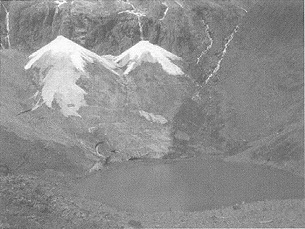
第三天,我們一大早做完早課,便由下雨崩村出發。路上非常的寂靜,走了四個多小時到神瀑。上得山來,我們提起勇氣在神瀑下穿梭繞行,身上也濕了;幾分鐘後,神瀑一共展示了三次彩虹,也令我們非常興奮。據說藏民在轉山時,必到神瀑下轉三至七圈,接受神瀑的洗禮。離開神瀑返下雨崩村,又要行四個小時;此時路上來照相的旅客才一一出現,有從歐洲來的、有從美洲來的國外人士(不知他們從那裏得來的消息,中國人反而沒有那麼多)。然後下山步行五個小時至溫泉處,藏民的行程是再步行至冰川,而完成七天的內轉;我們則是包車到冰川,車抵達時,我們都累呆了。我們沒有看見神山,但當我們以神水洗面之後,神山竟然露面了!卡瓦格博峰露出了全身及冰舌,將軍峰、梅裏皇后都露臉了,還對我們展示日落雪山。
1999年出了一件事,有三名日本人為了要征服這座山,在此住了三年,為登山而研究、準備。當地居民說,這三年他們經歷了有始以來的天災:一下乾旱,使得莊稼沒有收成;一下風災,處處不安寧。最後這三名日本人在攀岩時死在山上,到了好多年以後,才找到屍體;從此政府明令任何人不得攀岩此山,這座山才恢復了平靜。所以當地人認為,只要一看到日本旅遊團到時,就知道這幾天是看不到神山的;日本旅遊團走後,神山才會出現。藏民每年必到此神山來朝拜,再忙也都會帶著全家來此轉山,或三步一拜;也有很多拉薩的人來此朝拜,在路上可見成群結隊的藏民,帶著吃的及帳篷,以虔誠的心膜拜。在德欽休息一晚後,據說這幾天天氣好,沒有雨雪,滇藏公路還安全,我們在四千米的高度也已過了幾天,就決定一早坐車前往西藏。經過梅裏雪山時,什麼雪山都看不見,全被雲遮住得密密實實的;住在雪山對面客棧的遊客架著照相角架還在苦等。我們摸摸身上在下雨崩村被臭蟲咬腫的包,再捏捏小腿新長結實的肌肉,開開心心的往另一個旅程出發了。
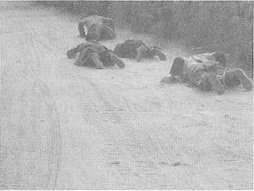 |
|
It was the Year of Goat and happened to be a leap year which happens once every sixty years. The Tibetans were circumambulating the mountain while reciting the “Six-word Brilliant Mantra”. A great circumambulation lasts 21 days, a minor circumambulation seven days. Since goats are sacred animals for Tibetans, it was a hugely significant event. We very much wanted to join, but we were feeling effects of the high altitude and were also afraid that the return path would be blocked if the snow came. Therefore, after we had had some local refreshments, we left reluctantly. When we were about halfway back, the sun began to rise in the east.
In October 2006, we spent three days to get through es where there were no covers, got to Deqing by car traveling along the Lanchang River, then entered the Meili Snow Mountain. A young man from Canton who took off a day earlier than us left with great disappointment. He said he had not seen anything because of the bad weather, not even a trace of the mountain. We decided to stay. We would turn inward once we entered the Meili Snow Mountain.
It rained during the first day. We walked six hours along the mountain path uphill to reach Xiayubeng village where we stayed. The following day the “golden gleaming of the summit” came forth again at the crack of dawn. Then we headed towards Binghu (Icy Lake). The scenery along the way was divinely magnificent. We climbed the mountain paths for four hours, passing through woodland, bamboo forest, and pine forest. Suddenly, we heard thundering noises that sounded like a stampede of ten thousand horses; as we looked up there was an avalanche over the other side of the mountain across the ravine. Blocks of snow were hurtling down the mountain; it was indeed a rare scene to witness.
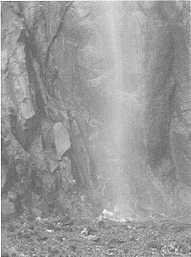 We continued to climbed until we reached the hanging Icy Lake. The little Icy Lake was formed by snow water melted by the sun. It flowed downstream into Lanchang river, then traveled thousands of miles into the Mekong River of Thailand before entering the South China Sea. Tibetans pray here at the Icy Lake; they respect mountains and water. We continued to climbed until we reached the hanging Icy Lake. The little Icy Lake was formed by snow water melted by the sun. It flowed downstream into Lanchang river, then traveled thousands of miles into the Mekong River of Thailand before entering the South China Sea. Tibetans pray here at the Icy Lake; they respect mountains and water.
On day three, we took off from Xiayubeng village after we finished our morning session real early. It was very quiet on the road. We walked four hours to the Divine Falls. When we got there, we plucked up our courage and circumambulated back and forth at the Divine Falls and got wet. Minutes later, we were excited to see three rainbows in succession at the waterfall. We heard that when Tibetans circumambulated the mountain, they would do three to seven rounds of spiritual cleansing under the Divine Falls. It took another four hours to get back to Xiayubeng village. At that time visitors who came for pictures started to show up, mostly Europeans and Americans. [I’m not sure how they knew about this place; there were not as many Chinese visitors.]
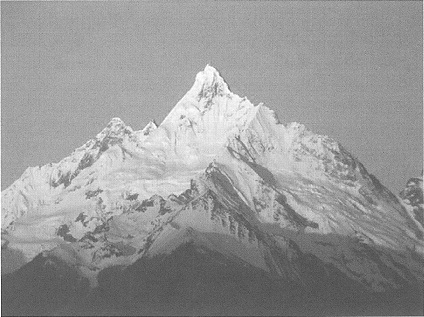
Another five hours by foot would elapse before we arrived at the hot springs. The journey for the Tibetans would go further by foot to the glacier, to finish off the seven-day inward circumambulation. As for us, we went to the glacier by chartered vehicle. We were tired and hardly able to move when we arrived. We didn’t see the “divine mountain”, but once we splashed our face with “divine water”, the “divine mountain” came forth, the full body and tongue of knasqen kawadgarbo emerged, the “General Summit” and “Queen of Meili” all appeared, passing through the great scene of sunset at the snowy mountain.
There was an incident in 1999, in which three Japanese attempted to scale this mountain. They stayed for three years researching for the climb and getting ready. The locals said the Japanese had experienced the worst catastrophic events ever. There were dry spells that wiped out all crops, and there were wind storms that turned places up side down; at the end the three Japanese died scaling the walls of the mountain. Their corpses were found a few years later. After that, the local government banned the scaling of the walls of that mountain. The mountain then became peaceful again. Locals believe that the divine mountain will not come forth whenever Japanese tourists are visiting; it will emerge only after they have left.
Tibetans make their pilgrimage to the divine mountain every year. No matter how busy they are, they will take the whole family here to circumambulate the mountain or do three steps, one bow. Many people from Lhasa City make pilgrimages here. One can see packs and bands of Tibetans carrying food and tents, offering their devout prayers.
After a night of rest in Deqing, we heard that the weather would be good for the next few days. With no rain or snow in the forecast, the Yunnan-Tibet highway would be relatively safe. We had already spent a few days at 4000 meters above sea level, so we decided to leave early in the morning for Tibet by car. When we passed by Meili Snow Mountain, it was totally invisible, covered by thick clouds. Those who were staying at the hotel across from the mountain were still out there with their cameras on tripods, ready and waiting!
As we examined with our hands the insect bite marks and bumps on our bodies which we had gotten in Xiayubeng village and felt the newly developed muscles on our lower legs, we cheerfully began our next journey. |